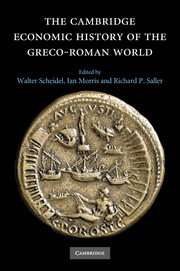Book contents
- Frontmatter
- 1 Introduction
- Part I Determinants of Economic Performance
- Part II Early Mediterranean Economies and the Near East
- Part III Classical Greece
- Part IV The Hellenistic States
- Part V Early Italy and the Roman Republic
- Part VI The Early Roman Empire
- Part VII Regional Development in the Roman Empire
- 24 The Western Provinces
- 25 The Eastern Mediterranean
- 26 Roman Egypt
- 27 The Frontier Zones
- Part VIII Epilogue
- Bibliography
- Index
- Map 1.1 The Mediterranean basin"
- Map 10.1 Greek and Phoenician trade in the period of the Persian Wars"
- Map 11.1 The Achaemenid empire"
- Map 12.1 Greece and Asia Minor"
- Map 15.1 The Seleucid empire"
- Map 16.1 Greco-Roman Egypt"
- Map 20.1 The Roman empire at the accession of Vespasian"
- References
25 - The Eastern Mediterranean
from Part VII - Regional Development in the Roman Empire
Published online by Cambridge University Press: 28 March 2008
- Frontmatter
- 1 Introduction
- Part I Determinants of Economic Performance
- Part II Early Mediterranean Economies and the Near East
- Part III Classical Greece
- Part IV The Hellenistic States
- Part V Early Italy and the Roman Republic
- Part VI The Early Roman Empire
- Part VII Regional Development in the Roman Empire
- 24 The Western Provinces
- 25 The Eastern Mediterranean
- 26 Roman Egypt
- 27 The Frontier Zones
- Part VIII Epilogue
- Bibliography
- Index
- Map 1.1 The Mediterranean basin"
- Map 10.1 Greek and Phoenician trade in the period of the Persian Wars"
- Map 11.1 The Achaemenid empire"
- Map 12.1 Greece and Asia Minor"
- Map 15.1 The Seleucid empire"
- Map 16.1 Greco-Roman Egypt"
- Map 20.1 The Roman empire at the accession of Vespasian"
- References
Summary
introduction
From the welter of disagreements and uncertainties surrounding the ancient economy at large, one presupposition often tacitly governs approaches to the Roman east. It is assumed that the eastern empire was less radically transformed, that it witnessed less “growth,” than its western counterpart or than the imperial heartland of Italy itself. Pre-existing high levels of urbanization, relatively greater distance from Rome, and a less pronounced military presence, are among the explanations offered to explain this phenomenon.
This assumption may very well be true, but it has contributed to a dominantly western orientation in many, if by no means all, general studies of the Roman economy. This chapter will take issue with this state of affairs in two respects. First, it is necessary to assess how far the state of our evidence dictates the perception and its consequences. And second, it is necessary to challenge the notion that “more change” is automatically better and more interesting, and that the economic history of the eastern provinces can thus be judged negatively and somewhat disregarded.
The Roman east is home to not a few famous facts and familiar insights into the workings of the ancient economy: tombstones record an impressive number of occupations at Corycus in Cilicia; Hadrian can be observed intervening in oil and fish prices in Athens; Dio Chrysostom speaks to the behavior of urban elites; the Talmud and the New Testament offer anecdotal testimony for everyday economic life. Culled principally from Greek authors of the early empire, or from “loquacious” cities and their rich epigraphic records, these pieces of evidence recur from one secondary account to the next.
Keywords
- Type
- Chapter
- Information
- The Cambridge Economic History of the Greco-Roman World , pp. 671 - 697Publisher: Cambridge University PressPrint publication year: 2007
References
- 12
- Cited by



